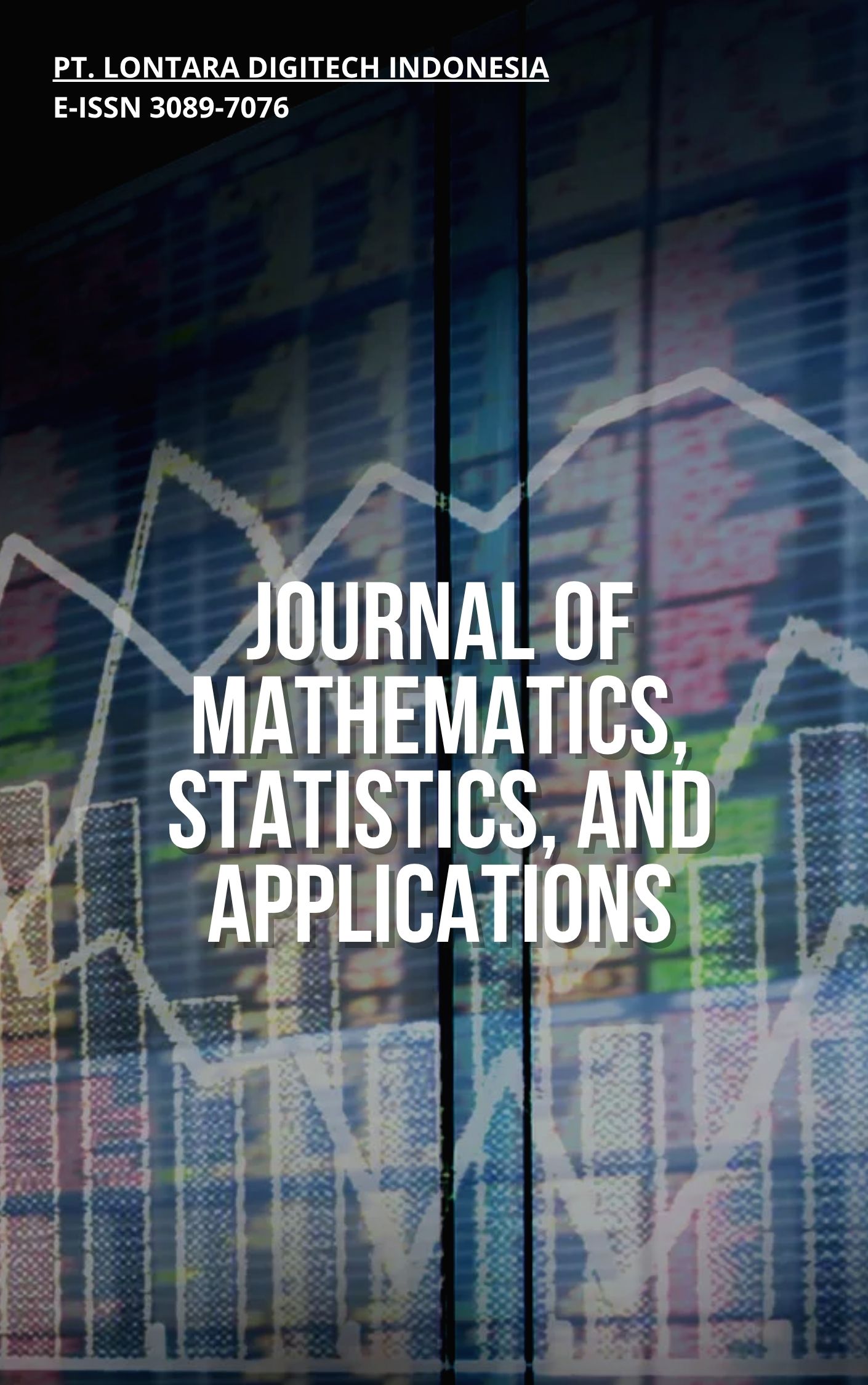Augmented Reality dalam Pembelajaran Geometri: Dampak, Tantangan, dan Arah Masa Depan
DOI:
https://doi.org/10.61220/Keywords:
Augmented Reality, pembelajaran geometri, kemampuan spasial, GeoGebra AR , literatur reviewAbstract
The development of digital technology in education has opened new opportunities for innovation in mathematics learning, particularly in geometry, which demands high spatial visualization skills. One rapidly developing innovation is Augmented Reality (AR), a technology that interactively combines real-world and virtual elements. This article is a systematic literature review that aims to examine the trends, effectiveness, and challenges of AR integration in geometry learning. Data were obtained from articles indexed in Scopus, Sinta, and Google Scholar, which were then analyzed thematically based on the research focus, empirical results, and their contribution to mathematics learning. The results of the study indicate that the application of AR can improve spatial ability, conceptual understanding, as well as student engagement and motivation in learning. Applications such as GeoGebra AR and 3D AR Escape Room have proven effective in supporting the visualization of geometric concepts and connecting theory to real-world contexts. However, the success of AR implementation is still influenced by factors such as device availability, teacher digital literacy, and pedagogical design that are not yet fully integrated. This study recommends the development of more adaptive and contextual AR-based learning models, as well as further research regarding the long-term impact of AR on higher-order geometric thinking skills.
Downloads
References
[1] I. Radu, “Augmented reality in education: A meta-review and cross-media analysis,” Pers. Ubiquitous Comput., vol. 18, no. 6, pp. 1533–1543, Jan. 2014, doi: 10.1007/S00779-013-0747-Y/METRICS.
[2] S. Gargrish, A. Mantri, and D. P. Kaur, “Augmented reality-based learning environment to enhance teaching-learning experience in geometry education,” in Procedia Computer Science, Elsevier B.V., 2020, pp. 1039–1046. doi: 10.1016/j.procs.2020.05.152.
[3] T. Koparan, H. Dinar, E. T. Koparan, and Z. S. Haldan, “Integrating augmented reality into mathematics teaching and learning and examining its effectiveness,” Think. Ski. Creat., vol. 47, Mar. 2023, doi: 10.1016/j.tsc.2023.101245.
[4] Lainufar, M. Mailizar, and R. Johar, “Exploring the potential use of GeoGebra augmented reality in a project-based learning environment: The case of geometry,” in Journal of Physics: Conference Series, IOP Publishing Ltd, May 2021. doi: 10.1088/1742-6596/1882/1/012045.
[5] F. Arwadi, A. Asmaun, and R. Ruslan, “Analisis Kesalahan Mahasiswa dalam Menyelesaikan Soal Analitik Ditinjau Dari Prestasi Belajar,” JRIP J. Ris. dan Inov. Pembelajaran, vol. 4, no. 3, p. 1819, 2024, doi: 10.51574/jrip.v4i3.2206.
[6] A. Asmaun, F. Arwadi, and M. Rifandi, “Deskripsi Kesalahan Mahasiswa dalam Menyelesaikan Soal Geometri Analitik Menurut Teori Newman Ditinjau dari Kemampuan Matematika,” Prox. J. Penelit. Mat. dan Pendidik. Mat., vol. 8, no. 2, pp. 548–560, 2025, doi: 10.30605/proximal.v8i2.5467.
[7] A. Asmaun, “Analisis Tingkat Berpikir Geometri Mahasiswa dalam Pemecahan Masalah Berdasarkan Teori Van Hiele pada Mata Kuliah Geometri Dasar,” Venn J. Sustain. Innov. Educ. Math. Nat. Sci., vol. 4, no. 3, pp. 378–396, Sep. 2025, doi: 10.53696/VENN.V4I3.353.
[8] M. Zapata, C. Ramos-Galarza, K. Valencia-Aragón, and L. Guachi, “Enhancing mathematics learning with 3D augmented reality escape room,” Int. J. Educ. Res. Open, vol. 7, Dec. 2024, doi: 10.1016/j.ijedro.2024.100389.
[9] T. H. Kramarenko, O. S. Pylypenko, and M. V Moiseienko, “Enhancing mathematics education with GeoGebra and augmented reality,” in CEUR Workshop Proceedings, 2024, pp. 117–126. [Online]. Available: https://kdpu.edu.ua/personal/tkramarenko.html
[10] Y. An, “History of Instructional Instructional Design , and Theories Media , To cite this article : of A History of Instructional Media , Instructional Design , and Theories,” Int. J. Technol. Educ., vol. 4, no. 1, pp. 1–21, 2019.
[11] A. Theodoropoulos and G. Lepouras, “Augmented Reality and programming education: A systematic review,” International Journal of Child-Computer Interaction, vol. 30. Elsevier B.V., Dec. 2021. doi: 10.1016/j.ijcci.2021.100335.
[12] W.-H. Chao and R.-C. Chang, “Using Augmented Reality to Enhance and Engage Students in Learning Mathematics,” Adv. Soc. Sci. Res. J., vol. 5, no. 12, Dec. 2018, doi: 10.14738/ASSRJ.512.5900.
[13] Z. Shaghaghian, H. Burte, D. Song, and W. Yan, “An Augmented Reality Application and User Study for Understanding and Learning Spatial Transformation Matrices,” arXiv Prepr. arXiv2212.00110, 2022.
[14] H. C. Gomez-Tone, J. Martin-Gutierrez, and B. K. Valencia-Anci, “Augmented and immersive virtual reality to train spatial skills in STEAM university students,” in Innovations in Artificial Intelligence and Human-Computer Interaction in the Digital Era, Elsevier, 2023, pp. 7–30. doi: 10.1016/B978-0-323-99891-8.00002-4.
[15] H. Pujiastuti and R. Haryadi, “The Effectiveness of Using Augmented Reality on the Geometry Thinking Ability of Junior High School Students,” in Procedia Computer Science, Elsevier B.V., 2024, pp. 1738–1745. doi: 10.1016/j.procs.2024.03.180.
[16] M. F. V. Ruslau, O. Dadi, and Nurlianti, “The impact of GeoGebra AR on students’ geometric thinking based on Van Hiele theory,” J. Honai Math, vol. 8, no. 1, pp. 115–128, Apr. 2025, doi: 10.30862/JHM.V8I1.871.
[17] N. Nurhami, N. Muharram, and W. Susanti, “Peningkatan Kemampuan Numerasi Siswa SMA Negeri 9 Luwu melalui Pembelajaran Etno-Matematika Berbasis Augmented Reality,” J. Dieksis ID, vol. 4, pp. 128–140, Dec. 2024, doi: 10.54065/dieksis.4.2.2024.521.
[18] P. Aditya, R. Ilma Indra Putri, E. Susanti, and N. Aisyah, “Augmented Reality (AR) pada Geogebra 3D untuk Menghasilkan Hypothetical Learning Trajectory Dalam Pembelajaran STEM Materi Jarak Dimensi Tiga Kelas XII SMA,” J. Pendidik. Mat. RAFA, vol. 8, no. 1, pp. 40–58, 2022, doi: 10.19109/jpmrafa.v8i1.8519.
[19] M. Akçayır and G. Akçayır, “Advantages and challenges associated with augmented reality for education: A systematic review of the literature,” Educ. Res. Rev., vol. 20, pp. 1–11, Feb. 2017, doi: 10.1016/j.edurev.2016.11.002.
[20] S. A. Yoon and J. Wang, “Making the Invisible Visible in Science Museums Through Augmented Reality Devices,” TechTrends 2013 581, vol. 58, no. 1, pp. 49–55, Dec. 2013, doi: 10.1007/S11528-013-0720-7.
[21] M. U. Gusteti et al., “Penggunaan Augmented Reality dalam Pembelajaran Matematika: Sebuah Analisis Berdasarkan Studi Literatur,” Edukatif J. Ilmu Pendidik., vol. 5, no. 6, pp. 2735–2747, 2023, doi: 10.31004/edukatif.v5i6.5963.
[22] H. K. Wu, S. W. Y. Lee, H. Y. Chang, and J. C. Liang, “Current status, opportunities and challenges of augmented reality in education,” Comput. Educ., vol. 62, pp. 41–49, Mar. 2013, doi: 10.1016/J.COMPEDU.2012.10.024.
[23] M. B. Ibáñez and C. Delgado-Kloos, “Augmented reality for STEM learning: A systematic review,” Comput. Educ., vol. 123, pp. 109–123, Aug. 2018, doi: 10.1016/j.compedu.2018.05.002.









 Email : ljmsa@lontaradigitech.com
Email : ljmsa@lontaradigitech.com
